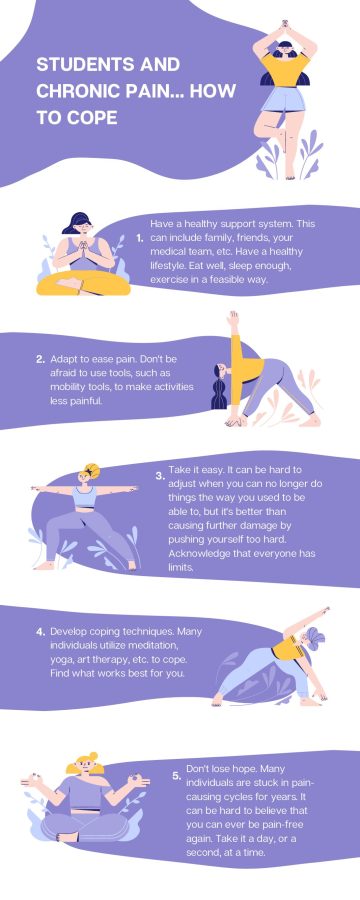A Picture of Pain: Students Seeking Answers to Chronic Pain
There are a lot of valid explanations for chronic pain even when tests and scans yield no answers. Don’t lose hope.
February 8, 2022
Many students are athletes, too. It’s common and normal for things to hurt and ache, but sometimes these injuries don’t heal like they’re supposed to. This leaves students in pain weeks, months, or even years later, taking away from their social life, education, athletics, and more.
Unfortunately, sometimes this pain can’t be explained by any structural injury like a broken bone or a pulled muscle. Students then are forced to turn to possible psychosomatic explanations, meaning physical symptoms caused by psychological or emotional factors.
Sadly, there is a major stigma surrounding psychosomatic pain. Contrary to popular belief, psychosomatic, also known as psychogenic, pain isn’t “made-up” pain. Many people experience headaches, stomachaches, or any other number of symptoms brought on by stress. This is psychosomatic pain, but the pain is inarguably felt all the same. In the same way as headaches, the brain can cause pain that is long-lasting and debilitating. Just as the brain can do medically inexplicable yet amazing things, the power of the brain can also have life-changing negative effects.
Suzanne O’Sullivan (MD), is an expert in psychosomatic illnesses. She’s treated cases far more severe than simple acute stress-induced headaches, such as cases of waist-down paralysis or seizures with no medical explanation. Many patients are offended by a diagnosis of psychosomatic pain: “Their first reaction is ‘you think I’m doing it on purpose’ or ‘you think it’s not real’,” said O’Sullivan. “There’s this perception that there is a degree of willfulness.”
Many individuals with psychosomatic symptoms report their oncoming coinciding with a significant life event with great emotional impact, such as loss of a job, death of a loved one, or other trauma. Many physicians specializing in psychosomatic chronic pain recommend cognitive behavioral therapy. With cognitive behavioral therapy (CBT), many patients are able to overcome the residual buried emotions that led to their symptoms in the first place. Contrarily, Dr. Howard Schubiner, author of “Unlearn Your Pain,” believes the best course of action is not CBT, but using mindfulness to break the cycle of pain. Schubiner is the director of the Mind Body Medicine Center in Southfield, Michigan. He’s worked with many patients with psychosomatic pain and helped them to break pain-causing mental patterns.
Still, there are sufferers of chronic pain who do not fit these psychosomatic characteristics. It is believed that their pain is due to ‘pain memory’—the nervous system continuing to send pain signals to the brain long after an initial injury has healed. Like an insidious nightmare, the pain lingers. As Sigmund Freud said, “I think this man is suffering from memories.” This results in not being able to find a medical cause through tests and scans, as the injury has structurally healed. This pain is known as neuropathic pain: the same pain as phantom limb pain. This pain can be treated with antidepressants or anti seizure medications, whether or not the individual has depression or seizures, or with different techniques such as transcutaneous electrical nerve stimulation (TENS).
Chronic pain can also be caused by an overactive spinal cord. This misinterpretation of nerve signals is known as central amplification of the peripheral pain signal. This is where normally inconsequential physical stimuli, such as putting on a sock or being under a blanket, is interpreted to be extremely painful. This is typically treated with a combination of therapies, such as CBT, physical therapy (PT), and/or occupational therapy (OT), as well as over-the-counter (OTC) or prescription pain medication.
In the end, there are a lot of valid explanations for chronic pain even when tests and scans yield no answers. Don’t lose hope.


